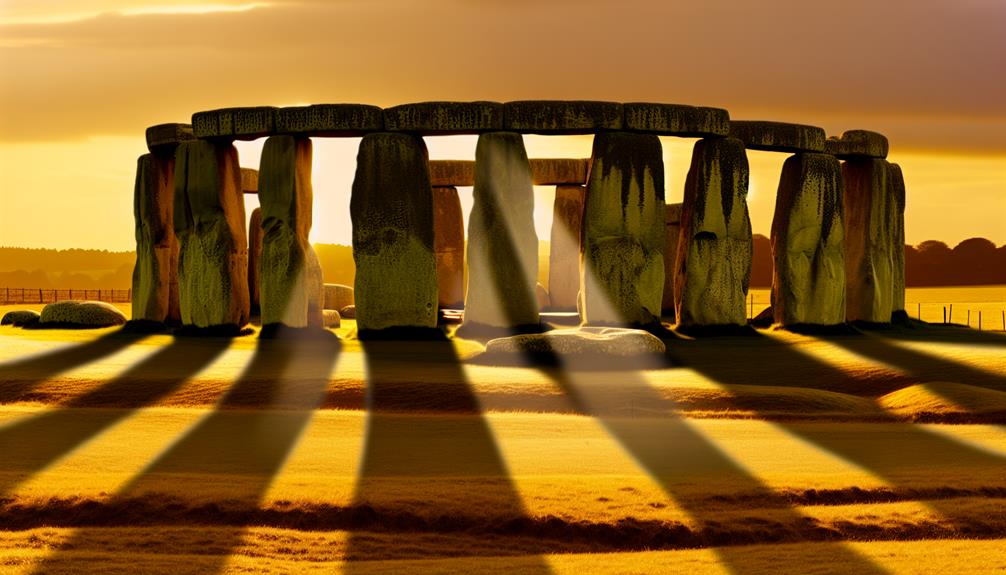The ancient city of Angkor Wat in Cambodia stands as a testament to human ingenuity and spiritual devotion. Its grandeur and historical significance have captivated visitors for centuries, drawing inquisitive minds to unravel the mysteries hidden within its walls. As we explore the intricate carvings, majestic structures, and hidden symbolism of this architectural wonder, a deeper understanding of the Khmer Empire's legacy and cultural heritage emerges. Join us on a journey through time and space as we uncover the secrets of Angkor Wat, a place where the past speaks volumes about the present and the future.
Key Takeaways
- Angkor Wat built in 12th century by King Suryavarman II, a Hindu temple dedicated to Vishnu.
- Represents Khmer civilization's architectural prowess with advanced engineering and intricate carvings.
- UNESCO World Heritage site covering over 400 acres, showcasing Hindu deities and myths.
- Preservation efforts ongoing, offering a blend of history, culture, and modern amenities for visitors.
- Tips: Start early, hire a guide, wear comfortable clothing, stay hydrated, and capture best lighting for photography.
History of Angkor Wat
The history of Angkor Wat dates back to the early 12th century when King Suryavarman II commissioned its construction as a Hindu temple dedicated to the god Vishnu. This UNESCO World Heritage site in Cambodia has ancient origins that speak volumes about the rich cultural heritage of the Khmer Empire. The temple complex covers an area of over 400 acres and is considered the largest religious monument in the world.
Angkor Wat's cultural significance lies in its architectural grandeur and intricate design, reflecting the Khmer Empire's devotion to both religion and art. The temple was originally built as a microcosm of the universe, with its five towers representing Mount Meru, the mythical abode of the gods in Hindu mythology. The intricate carvings on the walls depict scenes from Hindu epics such as the Ramayana and the Mahabharata, showcasing the cultural and religious influences of the time.
Over the centuries, Angkor Wat evolved from a Hindu temple to a Buddhist site, reflecting the changing religious practices in the region. Despite facing periods of neglect, Angkor Wat has stood the test of time, symbolizing the resilience and enduring legacy of the Khmer civilization. Today, it stands as a tribute to the ingenuity and artistic prowess of the ancient Khmer people, attracting visitors from around the world to marvel at its beauty and historical significance.
Architectural Marvels
With its intricate layout and towering structures, Angkor Wat stands as a tribute to the architectural marvels of the ancient Khmer civilization. The design techniques employed in the construction of Angkor Wat are a proof of the advanced engineering skills of the Khmer people. One of the construction secrets of Angkor Wat lies in the use of a sophisticated hydraulic system that allowed for water management within the temple complex.
The layout of Angkor Wat is meticulously planned, with a series of concentric galleries leading to the central towers. The use of sandstone blocks, quarried from a mountain 50 kilometers away, showcases the dedication and meticulous planning that went into the construction of this architectural wonder.
The temple's central tower, which rises to a height of 213 feet, is an engineering marvel in itself. The architects of Angkor Wat utilized a technique known as corbelling to construct the towers, a method that involves offsetting each successive row of stones to create a tapering effect. This construction technique not only provided structural stability but also added to the grandeur of the temple's design.
Symbolism and Hindu Influence
An exploration of the symbolism and Hindu influence at Angkor Wat reveals intricate connections between architectural design and religious belief systems of the ancient Khmer civilization. The temple complex, dedicated to the Hindu god Vishnu, showcases a profound spiritual significance through its design elements and carvings that depict various Hindu deities and myths.
To comprehend the Hindu influence at Angkor Wat, it is crucial to investigate the symbolism embedded in its architecture. Below is a table illustrating some of the key Hindu deities depicted at Angkor Wat and their significance:
| Hindu Deity | Representation | Spiritual Significance |
|---|---|---|
| Vishnu | Preserver god, often depicted with four arms holding a discus and conch shell | Symbolizes protection and preservation |
| Shiva | Destroyer god, shown with a third eye and a trident | Represents destruction of ignorance and rebirth |
| Brahma | Creator god, portrayed with four heads and hands | Symbolizes creation and cosmic order |
| Devi | Divine mother goddess, associated with strength and protection | Signifies feminine energy and nurturing qualities |
| Garuda | Bird-like creature, mount of Vishnu | Symbol of speed, strength, and freedom |
These representations not only highlight the diverse pantheon of Hindu deities but also emphasize the deep religious roots that influenced the construction of Angkor Wat, making it a profound symbol of spiritual devotion and cultural richness.
Visiting Angkor Wat Today
Exploring the contemporary experience of visiting Angkor Wat provides insight into the preservation efforts, accessibility enhancements, and cultural significance of this ancient temple complex in Cambodia. When visiting Angkor Wat today, tourists can expect a blend of history and modern amenities that make the experience both educational and comfortable. Here are some key aspects of visiting Angkor Wat in the present day:
- Preservation Efforts: The management of Angkor Wat has made significant strides in preserving the temple complex for future generations. Conservation projects have been ongoing to protect the intricate carvings, stone structures, and surrounding environment.
- Accessibility Enhancements: In recent years, there have been improvements to make Angkor Wat more accessible to visitors. This includes better signage, pathways, and facilities to accommodate tourists of all ages and physical abilities.
- Cultural Significance: Angkor Wat remains a symbol of Cambodia's rich cultural heritage and is a source of national pride. Visitors can immerse themselves in the history and spirituality of the site, gaining a deeper understanding of the country's past.
- Local Cuisine: Exploring Angkor Wat today also offers the opportunity to savor the flavors of Cambodian cuisine. Visitors can enjoy local dishes at nearby restaurants and food stalls, adding a culinary dimension to their cultural experience.
Tips for Exploring the Temple
Exploring Angkor Wat efficiently necessitates strategic planning and an understanding of the temple's layout and historical significance. To make the most of your visit, start early in the morning to avoid crowds and the intense midday heat. Consider hiring a knowledgeable guide to provide insights into the temple's rich history and architectural marvels.
When exploring Angkor Wat, it is vital to wear comfortable clothing and sturdy shoes as you will be walking and climbing stairs throughout the complex. Bring along sufficient water to stay hydrated, and consider carrying a small backpack for your essentials.
For photography enthusiasts, the best lighting for capturing the intricate details of Angkor Wat is during the early morning or late afternoon. Be patient and take your time to find unique angles and perspectives to showcase the grandeur of the temple in your photos.
To fully appreciate the vastness of Angkor Wat, plan to spend at least a full day exploring the main temple as well as the surrounding ruins. Take breaks to rest and absorb the beauty and tranquility of this UNESCO World Heritage site. By following these exploration tips and photography advice, you can create lasting memories of your visit to Angkor Wat.
Frequently Asked Questions
Are There Any Hidden Chambers or Secret Passageways in Angkor Wat?
Hidden chambers and secret passageways in historical structures have long fascinated researchers and enthusiasts alike. These architectural mysteries often spark curiosity and intrigue, leading to extensive exploration and speculation.
Uncovering such hidden elements within ancient buildings can provide valuable insights into the construction methods, cultural practices, and historical significance of these structures. The presence of hidden chambers adds an element of mystery and allure to these architectural wonders, prompting further investigation and discovery.
Can Visitors Witness Any Traditional Cambodian Ceremonies or Rituals at the Temple?
Visitors seeking to experience traditional Cambodian ceremonies and rituals can witness a variety of cultural practices, spiritual events, and ancient traditions.
Local customs often include religious events that showcase the rich heritage of Cambodia. These rituals offer a glimpse into the profound connection between the people and their beliefs, providing a unique insight into the cultural tapestry woven through generations.
Witnessing these ceremonies can be a transformative and enlightening experience for visitors.
Are There Any Superstitions or Local Myths Associated With Angkor Wat?
Local beliefs and folklore traditions often shape the narratives surrounding historical sites. Superstitions and myths contribute to the cultural significance of many landmarks, adding layers of intrigue and mystery to their stories.
Understanding the local beliefs and folklore associated with a place provides insight into the community's values and traditions, enriching the visitor experience and fostering a deeper appreciation for the site's heritage.
What Wildlife Can Be Observed in and Around the Temple Complex?
Bird watching enthusiasts will delight in the diverse avian species that can be observed in and around the temple complex. From vibrant tropical birds to majestic raptors, the area offers a rich tapestry of wildlife for observation.
Additionally, visitors may also encounter playful monkey sightings, adding an element of charm and excitement to the experience. The combination of bird watching and monkey sightings creates a unique and memorable wildlife experience for all who visit.
Are There Any Lesser-Known or Off-The-Beaten-Path Temples Near Angkor Wat Worth Exploring?
When seeking unexplored temples for a serene sanctuary and cultural immersion, off-the-beaten-path destinations offer a glimpse into rural charm and historical significance. Venturing beyond popular sites can reveal hidden gems that provide a unique and authentic experience.
These lesser-known temples often showcase intricate architecture, rich cultural heritage, and a tranquil atmosphere, making them worth exploring for those seeking a deeper connection with the region's history and spirituality.
Conclusion
To wrap up, Angkor Wat stands as a testament to the architectural and cultural achievements of ancient Cambodia. Its intricate carvings, sophisticated design, and historical significance continue to captivate visitors from around the world.
As one of the largest religious monuments globally, Angkor Wat's blend of Hindu symbolism and architectural marvels make it a must-see destination for those seeking to explore the rich history and cultural heritage of Southeast Asia.


